Nursing Tips
Medical-Surgical (116)

Systemic Lupus Erythematosus (SLE)
A patient with Systemic Lupus Erythematosus (SLE) has some classic findings including fatigue, joint pain, fever, butterfly rash on the face, Raynaud's phenomenon, and a positive ANA titer.
Systemic Lupus Erythematosus (SLE)
A patient with Systemic Lupus Erythematosus (SLE) has some classic findings including fatigue, joint pain, fever, butterfly rash on the face, Raynaud's phenomenon, and a positive ANA titer.

Addison's Disease
A patient with Addison's Disease (a form of adrenocortical insufficiency) will have increased potassium, calcium, and BUN, but decreased cortisol, sodium, and glucose.
Addison's Disease
A patient with Addison's Disease (a form of adrenocortical insufficiency) will have increased potassium, calcium, and BUN, but decreased cortisol, sodium, and glucose.
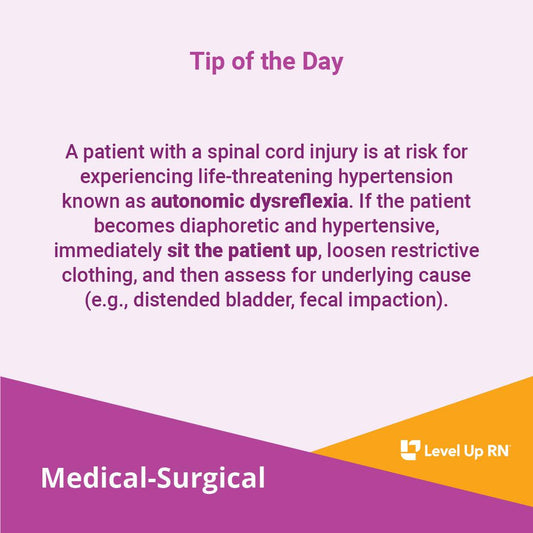
Autonomic Dysreflexia
A patient with a spinal cord injury is at risk for experiencing life-threatening hypertension known as autonomic dysreflexia.
Autonomic Dysreflexia
A patient with a spinal cord injury is at risk for experiencing life-threatening hypertension known as autonomic dysreflexia.
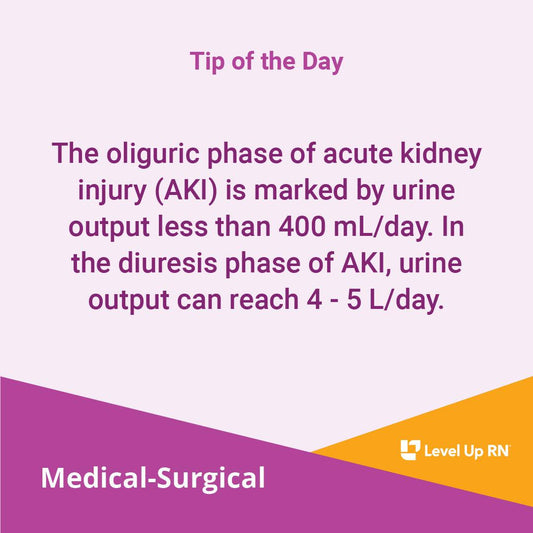
Acute Kidney Injury (AKI) : Oliguric Phase
The oliguric phase of acute kidney injury (AKI) is marked by urine output less than 400 mL/day. In the diuresis phase of AKI, urine output can reach 4 - 5...
Acute Kidney Injury (AKI) : Oliguric Phase
The oliguric phase of acute kidney injury (AKI) is marked by urine output less than 400 mL/day. In the diuresis phase of AKI, urine output can reach 4 - 5...

Tonic-clonic Seizure
After a tonic-clonic seizure, a patient enters the "postictal phase," and may exhibit confusion, sleepiness, or agitation.
Tonic-clonic Seizure
After a tonic-clonic seizure, a patient enters the "postictal phase," and may exhibit confusion, sleepiness, or agitation.
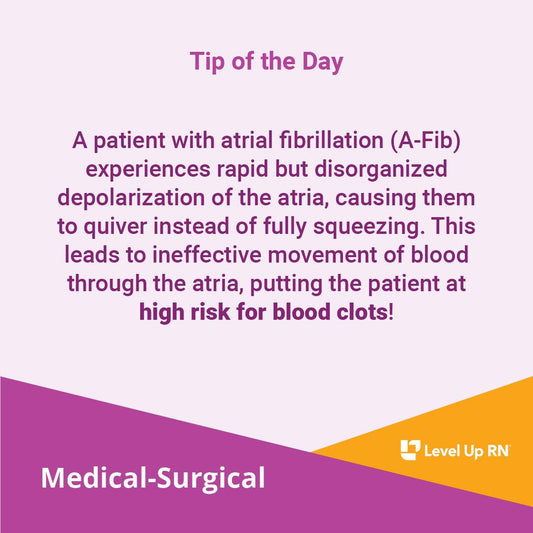
Atrial Fibrillation (A-Fib)
A patient with atrial fibrillation (A-Fib) experiences rapid but disorganized depolarization of the atria, causing them to quiver instead of fully squeezing.
Atrial Fibrillation (A-Fib)
A patient with atrial fibrillation (A-Fib) experiences rapid but disorganized depolarization of the atria, causing them to quiver instead of fully squeezing.

Fibrocystic Breast Changes: Patient Education
A patient with fibrocystic breast changes may experience breast pain and/or movable, tender, rubber-like cysts in the upper outer quadrant of the breast.
Fibrocystic Breast Changes: Patient Education
A patient with fibrocystic breast changes may experience breast pain and/or movable, tender, rubber-like cysts in the upper outer quadrant of the breast.

Abdominal Aortic Aneurysm
A patient with an Abdominal Aortic Aneurysm may have a pulsating abdominal mass with a bruit. Do NOT palpate this due to the risk for rupture!
Abdominal Aortic Aneurysm
A patient with an Abdominal Aortic Aneurysm may have a pulsating abdominal mass with a bruit. Do NOT palpate this due to the risk for rupture!

Sinus Bradycardia
A patient with sinus bradycardia will likely require no treatment. However, if they are symptomatic, treatment with atropine or a pacemaker may be indicated.
Sinus Bradycardia
A patient with sinus bradycardia will likely require no treatment. However, if they are symptomatic, treatment with atropine or a pacemaker may be indicated.

Hyperpituitarism
A patient with hyperpituitarism may require surgical treatment with a hypophysectomy.
Hyperpituitarism
A patient with hyperpituitarism may require surgical treatment with a hypophysectomy.

Cardiac Tamponade
A patient with paradoxical pulse and an EKG showing electrical alternans should be evaluated for cardiac tamponade.
Cardiac Tamponade
A patient with paradoxical pulse and an EKG showing electrical alternans should be evaluated for cardiac tamponade.

Tension Pneumothorax
A patient with a tension pneumothorax is likely to have tracheal deviation towards the unaffected side. Assess respiratory status in any patient with this finding!
Tension Pneumothorax
A patient with a tension pneumothorax is likely to have tracheal deviation towards the unaffected side. Assess respiratory status in any patient with this finding!
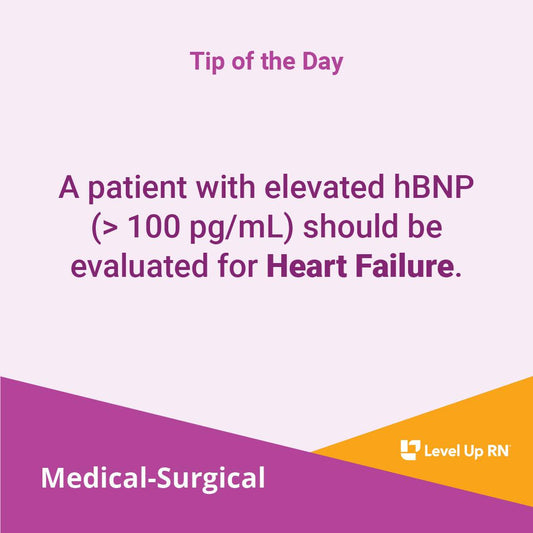
Elevated hBNP
A patient with elevated hBNP (> 100 pg/mL) should be evaluated for Heart Failure.
Elevated hBNP
A patient with elevated hBNP (> 100 pg/mL) should be evaluated for Heart Failure.
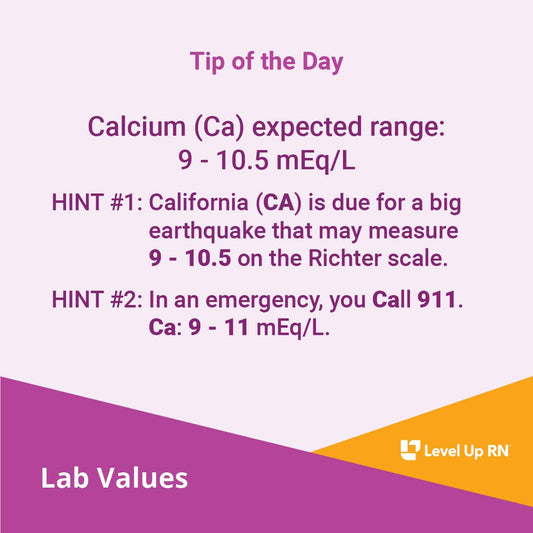
Calcium Ranges
Calcium (Ca) expected range: 9 - 10.5 mEq/L HINT: California (CA) is due for a big earthquake that may measure 9 - 10.5 on the Richter scale.
Calcium Ranges
Calcium (Ca) expected range: 9 - 10.5 mEq/L HINT: California (CA) is due for a big earthquake that may measure 9 - 10.5 on the Richter scale.

Long-bone Fractures
A patient who experienced a long-bone fracture is at risk for a fat embolism. Immediately report any dyspnea, confusion, tachypnea, tachycardia, or chest pain to the provider.
Long-bone Fractures
A patient who experienced a long-bone fracture is at risk for a fat embolism. Immediately report any dyspnea, confusion, tachypnea, tachycardia, or chest pain to the provider.

Appendicitis: Nursing Care
A patient with appendicitis is likely to have RLQ pain at McBurney's Point along with rebound tenderness, nausea/vomiting, and fever.
Appendicitis: Nursing Care
A patient with appendicitis is likely to have RLQ pain at McBurney's Point along with rebound tenderness, nausea/vomiting, and fever.

Hemodialysis: Patient Teaching
A patient undergoing hemodialysis may have an arteriovenous fistula in the arm. Educate patient that blood pressures, IVs, and blood draws must be done from the arm without the shunt....
Hemodialysis: Patient Teaching
A patient undergoing hemodialysis may have an arteriovenous fistula in the arm. Educate patient that blood pressures, IVs, and blood draws must be done from the arm without the shunt....

Status Asthmaticus
A patient with asthma who is experiencing airway obstruction unresponsive to usual therapy is experiencing status asthmaticus. Administer oxygen and prepare for emergency intubation!
Status Asthmaticus
A patient with asthma who is experiencing airway obstruction unresponsive to usual therapy is experiencing status asthmaticus. Administer oxygen and prepare for emergency intubation!

Varicose Veins: Patient Teaching
A patient who experiences prolonged standing (like nurses!) is at risk for developing varicose veins. Educate patients with this risk factor to wear compression stockings and elevate the legs when...
Varicose Veins: Patient Teaching
A patient who experiences prolonged standing (like nurses!) is at risk for developing varicose veins. Educate patients with this risk factor to wear compression stockings and elevate the legs when...

Loss of Central Vision
A patient reporting a loss of central vision should be evaluated for macular degeneration.
Loss of Central Vision
A patient reporting a loss of central vision should be evaluated for macular degeneration.

Assessing Skin Lesions with ABCDE
Assess any skin lesions for potential cancerous changes using ABCDE.
Assessing Skin Lesions with ABCDE
Assess any skin lesions for potential cancerous changes using ABCDE.
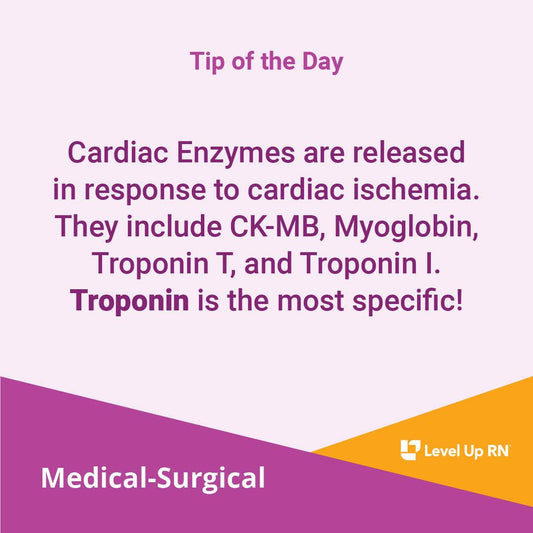
Cardiac Enzymes
Cardiac Enzymes are released in response to cardiac ischemia. They include CK-MB, Myoglobin, Troponin T, and Troponin I. Troponin is the most specific!
Cardiac Enzymes
Cardiac Enzymes are released in response to cardiac ischemia. They include CK-MB, Myoglobin, Troponin T, and Troponin I. Troponin is the most specific!

Chancre
A patient presenting with a chancre (ulcer) on the genitals should be evaluated for syphilis. The chancre should be cultured, and a blood test should be done to assess for...
Chancre
A patient presenting with a chancre (ulcer) on the genitals should be evaluated for syphilis. The chancre should be cultured, and a blood test should be done to assess for...
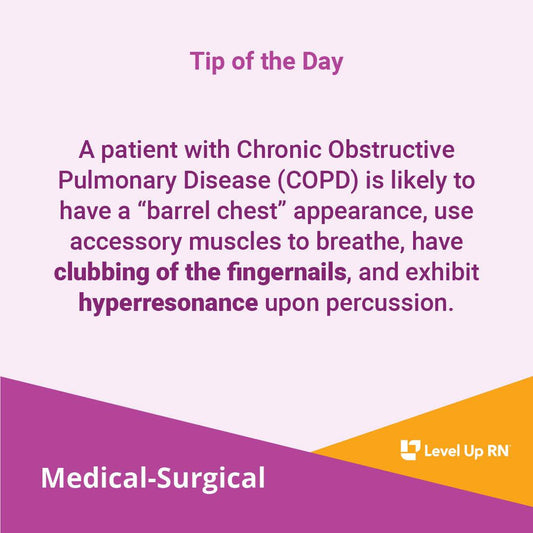
Chronic Obstructive Pulmonary Disease (COPD): Signs & Symptoms
A patient with Chronic Obstructive Pulmonary Disease (COPD) is likely to have a "barrel chest" appearance, use accessory muscles to breathe, have clubbing of the fingernails, and exhibit hyperresonance upon...
Chronic Obstructive Pulmonary Disease (COPD): Signs & Symptoms
A patient with Chronic Obstructive Pulmonary Disease (COPD) is likely to have a "barrel chest" appearance, use accessory muscles to breathe, have clubbing of the fingernails, and exhibit hyperresonance upon...

Disseminated Intravascular Coagulopathy (DIC)
A client experiencing shock is at risk for Disseminated Intravascular Coagulopathy (DIC). Monitor for signs of clotting/bleeding and report any of these findings promptly.
Disseminated Intravascular Coagulopathy (DIC)
A client experiencing shock is at risk for Disseminated Intravascular Coagulopathy (DIC). Monitor for signs of clotting/bleeding and report any of these findings promptly.

Ostomy Patient Teaching
Ostomy patient teaching: Cut opening in skin barrier ≤ 1/8" bigger than the measured stoma size to prevent skin damage from contact with ostomy output. Assess stoma regularly - should...
Ostomy Patient Teaching
Ostomy patient teaching: Cut opening in skin barrier ≤ 1/8" bigger than the measured stoma size to prevent skin damage from contact with ostomy output. Assess stoma regularly - should...
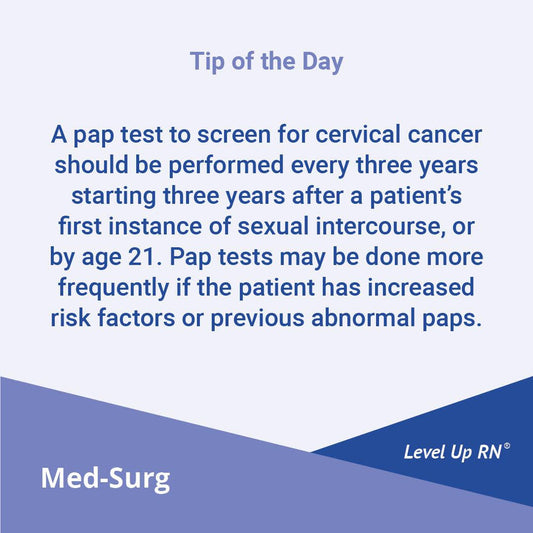
Pap Tests
A pap test to screen for cervical cancer should be performed every three years starting three years after a patient's first instance of sexual intercourse, or by age 21.
Pap Tests
A pap test to screen for cervical cancer should be performed every three years starting three years after a patient's first instance of sexual intercourse, or by age 21.

Negative Feedback Loop
A negative feedback loop governs most endocrine hormones. In this type of feedback, when the body senses there is not enough of a hormone circulating in the blood, changes are...
Negative Feedback Loop
A negative feedback loop governs most endocrine hormones. In this type of feedback, when the body senses there is not enough of a hormone circulating in the blood, changes are...

Peptic Ulcer Disease: Signs and Symptoms
A major complication of peptic ulcer disease is perforation of an ulcer. Assess for symptoms of perforation such as severe pain, fever, or a rigid/boardlike abdomen.
Peptic Ulcer Disease: Signs and Symptoms
A major complication of peptic ulcer disease is perforation of an ulcer. Assess for symptoms of perforation such as severe pain, fever, or a rigid/boardlike abdomen.
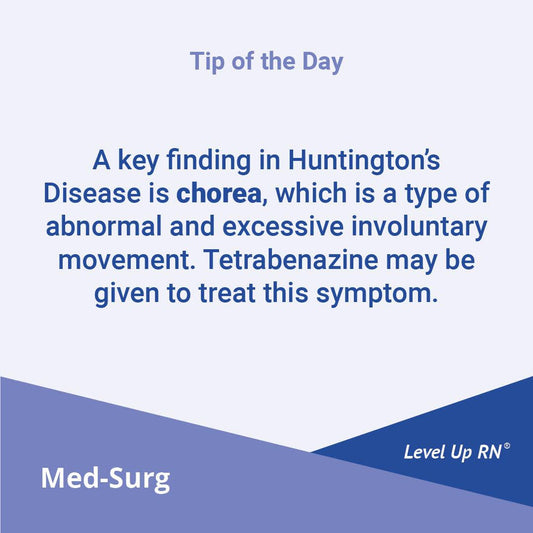
Chorea and Huntington's Disease
A key finding in Huntington's Disease is chorea, which is a type of abnormal and excessive involuntary movement. Tetrabenazine may be given to treat this symptom.
Chorea and Huntington's Disease
A key finding in Huntington's Disease is chorea, which is a type of abnormal and excessive involuntary movement. Tetrabenazine may be given to treat this symptom.
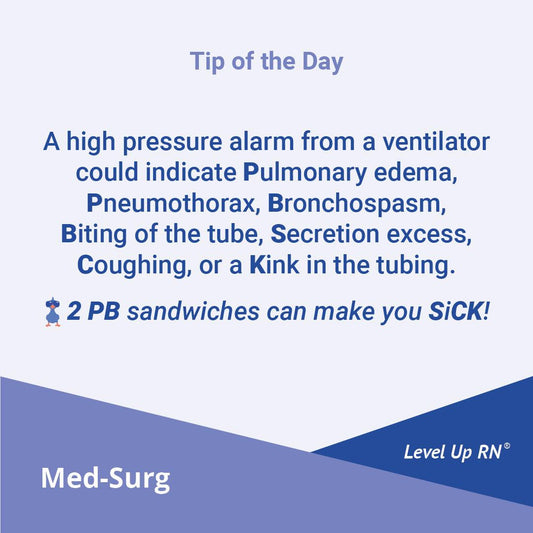
High Pressure Alarm: Causes
A high pressure alarm from a ventilator could indicate Pulmonary edema, Pneumothorax, Bronchospasm, Biting of the tube, Secretion excess, Coughing, or a Kink in the tubing.
High Pressure Alarm: Causes
A high pressure alarm from a ventilator could indicate Pulmonary edema, Pneumothorax, Bronchospasm, Biting of the tube, Secretion excess, Coughing, or a Kink in the tubing.

Bronchoscopy: Nursing Care
Following a bronchoscopy (visualization of the structures of the airway with sedation), ensure the patient's gag reflex has returned prior to allowing the patient to eat or drink.
Bronchoscopy: Nursing Care
Following a bronchoscopy (visualization of the structures of the airway with sedation), ensure the patient's gag reflex has returned prior to allowing the patient to eat or drink.

Burn Inhalation Injury
For a patient who has suffered a BURN, be sure to assess for inhalation injury. Symptoms: singed eyebrows or nasal hair, and sooty sputum.
Burn Inhalation Injury
For a patient who has suffered a BURN, be sure to assess for inhalation injury. Symptoms: singed eyebrows or nasal hair, and sooty sputum.
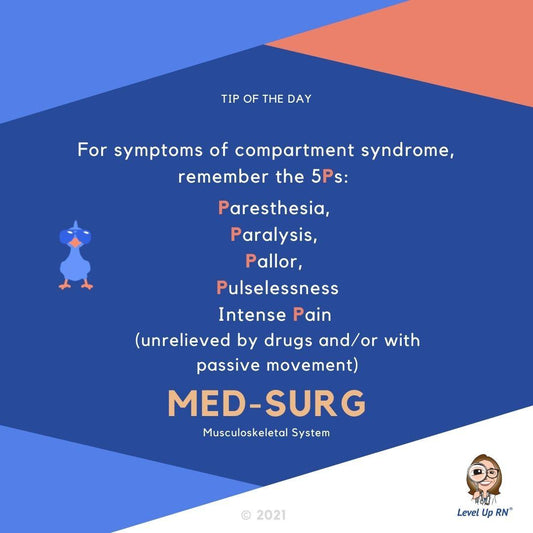
Compartment Syndrome 5Ps
For symptoms of compartment syndrome, remember the 5Ps: Paresthesia, Paralysis, Pallor, Pulselessness, Intense Pain
Compartment Syndrome 5Ps
For symptoms of compartment syndrome, remember the 5Ps: Paresthesia, Paralysis, Pallor, Pulselessness, Intense Pain
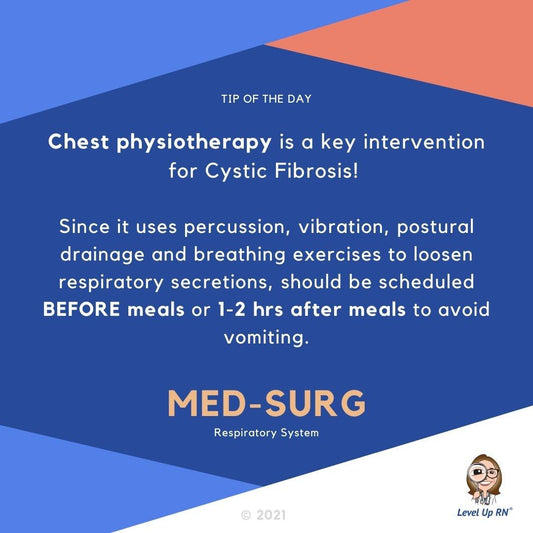
Chest Physiotherapy Treatments
Chest physiotherapy treatments should be included 1 hour before or 2 hours after meals to avoid vomiting.
Chest Physiotherapy Treatments
Chest physiotherapy treatments should be included 1 hour before or 2 hours after meals to avoid vomiting.
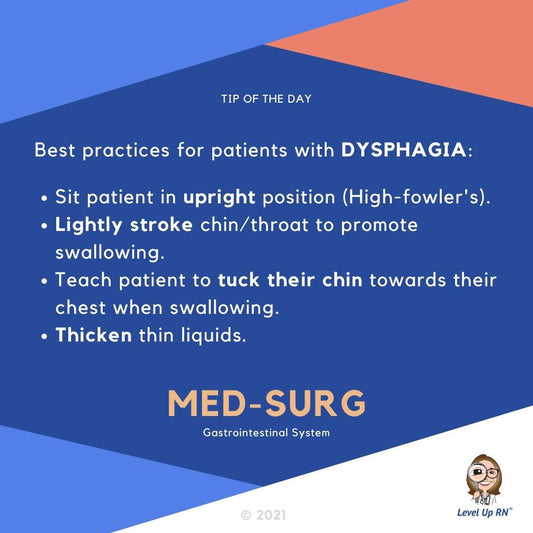
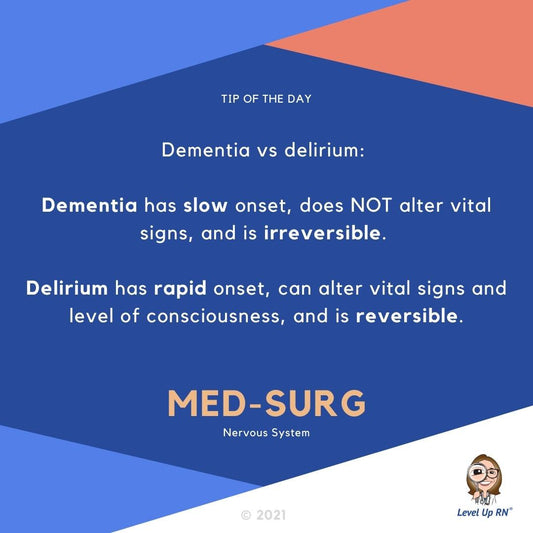
Dementia vs. delirium
Dementia vs delirium: Dementia has slow onset, does NOT alter vital signs, and is irreversible. Delirium has rapid onset, can alter vital signs and level of consciousness, and is reversible.
Dementia vs. delirium
Dementia vs delirium: Dementia has slow onset, does NOT alter vital signs, and is irreversible. Delirium has rapid onset, can alter vital signs and level of consciousness, and is reversible.
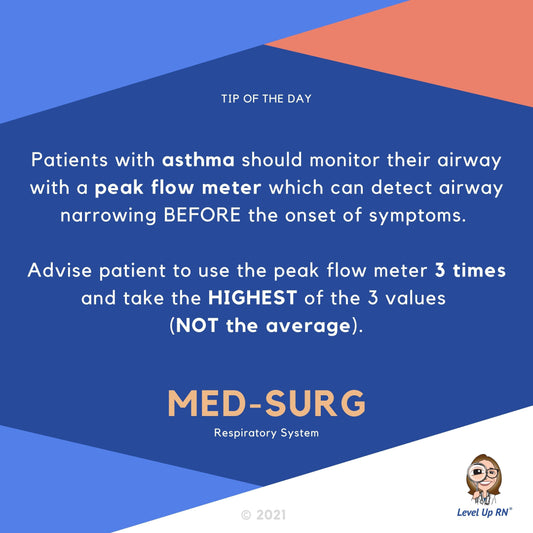
Lung capacity measurement
Patients with asthma should monitor their airway with a peak flow meter.
Lung capacity measurement
Patients with asthma should monitor their airway with a peak flow meter.
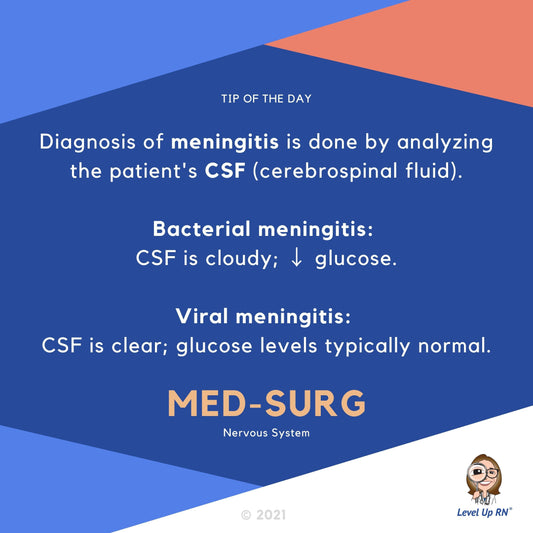
Meningitis diagnosis
Diagnosis of meningitis is done by analyzing the patient's CSF (cerebrospinal fluid).
Meningitis diagnosis
Diagnosis of meningitis is done by analyzing the patient's CSF (cerebrospinal fluid).
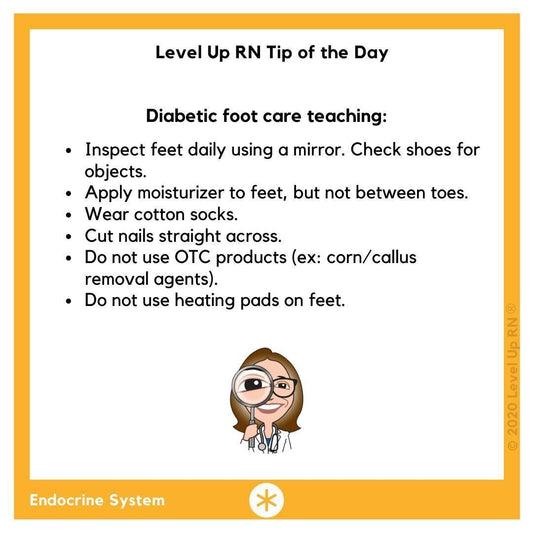
Diabetic Foot Care
Diabetic foot care teaching: Inspect feet; Apply moisturizer; Wear cotton socks; Cut nails straight across; Don't use OTC products or use heating pads on feet.
Diabetic Foot Care
Diabetic foot care teaching: Inspect feet; Apply moisturizer; Wear cotton socks; Cut nails straight across; Don't use OTC products or use heating pads on feet.
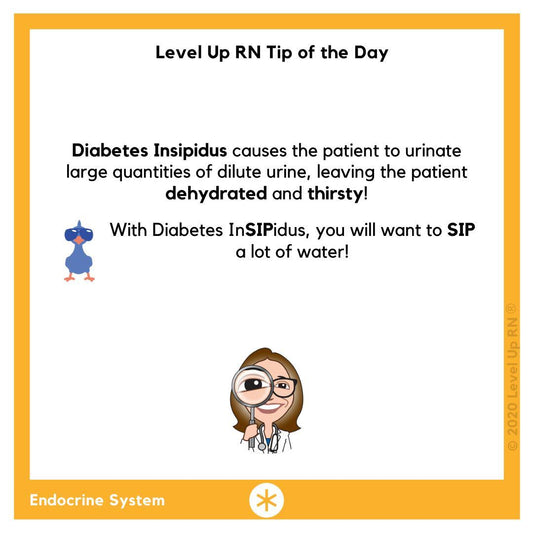
Diabetes Insipidus
With Diabetes InSIPidus, you will want to SIP a lot of water. Diabetes Insipidus causes the patient to urinate large quantities of dilute urine, leaving the patient dehydrated and thirsty!
Diabetes Insipidus
With Diabetes InSIPidus, you will want to SIP a lot of water. Diabetes Insipidus causes the patient to urinate large quantities of dilute urine, leaving the patient dehydrated and thirsty!
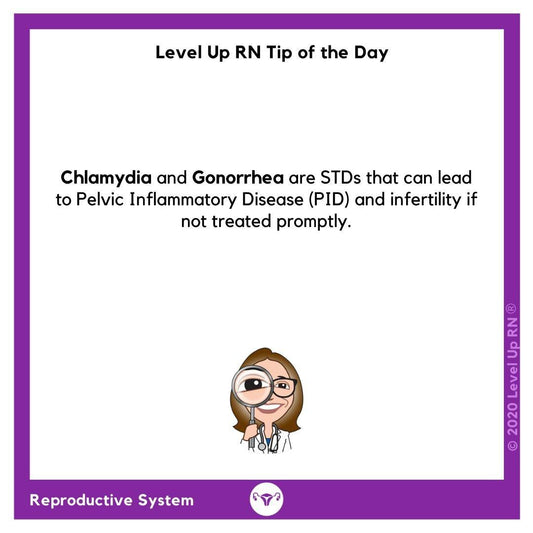
Chlamydia & Gonorrhea
Chlamydia and Gonorrhea are STDs that can lead to Pelvic Inflammatory Disease (PID) and infertility if not treated promptly.
Chlamydia & Gonorrhea
Chlamydia and Gonorrhea are STDs that can lead to Pelvic Inflammatory Disease (PID) and infertility if not treated promptly.

Innate v. Acquired Immunity
Innate vs. Acquired Immunity Pathophysiology
Innate v. Acquired Immunity
Innate vs. Acquired Immunity Pathophysiology
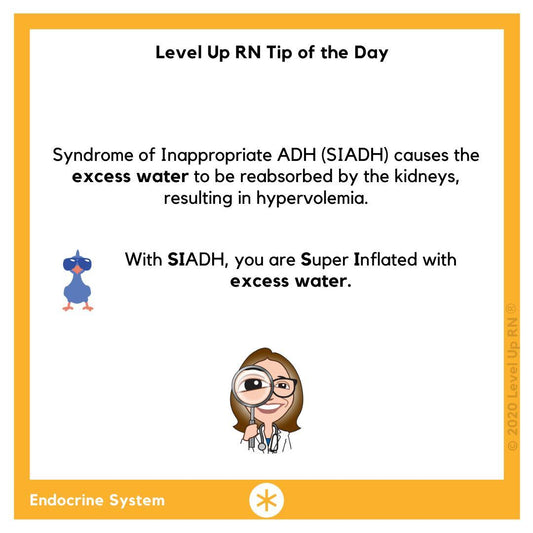
Syndrome of Inappropriate ADH
Syndrome of Inappropriate ADH (SIADH) causes the excess water to be reabsorbed by the kidneys, resulting in hypervolemia.
Syndrome of Inappropriate ADH
Syndrome of Inappropriate ADH (SIADH) causes the excess water to be reabsorbed by the kidneys, resulting in hypervolemia.

Dysphagia
Patients with dysphagia (difficulty swallowing) need to have a swallow evaluation by a speech language pathologist.
Dysphagia
Patients with dysphagia (difficulty swallowing) need to have a swallow evaluation by a speech language pathologist.

Rheumatoid Arthritis Labs
Expected labs with Rheumatoid Arthritis: Positive Rheumatoid Factor (RF) antibody and Positive ANA titer
Rheumatoid Arthritis Labs
Expected labs with Rheumatoid Arthritis: Positive Rheumatoid Factor (RF) antibody and Positive ANA titer

Menorrhagia
Menorrhagia = Excessive menstrual bleeding. This can result in anemia.If you have menorrhagia, it will make you want to rage!
Menorrhagia
Menorrhagia = Excessive menstrual bleeding. This can result in anemia.If you have menorrhagia, it will make you want to rage!
Filter Articles
Shop
The Ultimate Nursing School Survival Kit - with Flashables and Membership
4.875 / 5.0
(240) 240 total reviews
Regular price $349.95Regular priceUnit price / per$817.95Sale price $349.95SaleVideos by Subject
Tips & More
Exam Information
Subscribe



